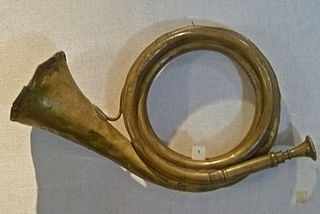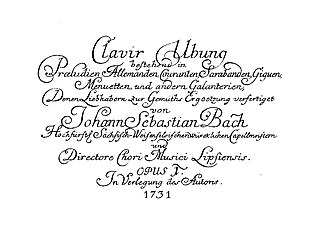
Carl Philipp Emanuel Bach, also formerly spelled Karl Philipp Emmanuel Bach, and commonly abbreviated C. P. E. Bach, was a German Classical period composer and musician, the fifth child and second surviving son of Johann Sebastian Bach and Maria Barbara Bach.

Johann Ludwig Bach was a German composer and violinist.

The title Notebook for Anna Magdalena Bach refers to either of two manuscript notebooks that the German Baroque composer Johann Sebastian Bach presented to his second wife, Anna Magdalena. Keyboard music makes up most of both notebooks, and a few pieces for voice are included.
The year 1704 in music involved some significant events.
A capriccio or caprice, is a piece of music, usually fairly free in form and of a lively character. The typical capriccio is one that is fast, intense, and often virtuosic in nature.

The post horn is a valveless cylindrical brass instrument with a cupped mouthpiece. The instrument was used to signal the arrival or departure of a post rider or mail coach. It was used by postilions of the 18th and 19th centuries.

The Partitas, BWV 825–830, are a set of six keyboard suites written by Johann Sebastian Bach, published individually beginning in 1726, then together as Clavier-Übung I in 1731, the first of his works to be published under his own direction. They were, however, among the last of his keyboard suites to be composed, the others being the six English Suites, BWV 806-811 and the six French Suites, BWV 812-817, as well as the Overture in the French style, BWV 831.
"Bist du bei mir, geh ich mit Freuden" is an aria from Gottfried Heinrich Stölzel's opera Diomedes, which was first staged on 16 November 1718. The aria is best known as "Bist du bei mir," BWV 508, a version for voice and continuo found as No. 25 in the 1725 Notebook for Anna Magdalena Bach.
Johann Jacob Bach was a German musician, composer and an older brother of Johann Sebastian Bach.

Johann Sebastian Bach was a German composer and musician of the late Baroque period. He is known for his orchestral music such as the Brandenburg Concertos; solo instrumental works such as the cello suites and sonatas and partitas for solo violin; keyboard works such as the Goldberg Variations and The Well-Tempered Clavier; organ works such as the Schubler Chorales and the Toccata and Fugue in D minor; and choral works such as the St Matthew Passion and the Mass in B minor.

Jesus nahm zu sich die Zwölfe, BWV 22, is a church cantata by Johann Sebastian Bach composed for Quinquagesima, the last Sunday before Lent. Bach composed it as an audition piece for the position of Thomaskantor in Leipzig and first performed it there on 7 February 1723.

The Bach-Busoni Editions are a series of publications by the Italian pianist-composer Ferruccio Busoni (1866–1924) containing primarily piano transcriptions of keyboard music by Johann Sebastian Bach. They also include performance suggestions, practice exercises, musical analysis, an essay on the art of transcribing Bach's organ music for piano, an analysis of the fugue from Beethoven's 'Hammerklavier' sonata, and other related material. The later editions also include free adaptations and original compositions by Busoni which are based on the music of Bach.

Uns ist ein Kind geboren, BWV 142 / Anh. II 23, is a Christmas cantata by an unknown composer. In the Bach-Werke-Verzeichnis it is listed among the works with a doubtful attribution to Johann Sebastian Bach. The text is based on a libretto by Erdmann Neumeister first published in 1711. Although attributed to Bach by the Bach-Gesellschaft when they first published it in the late nineteenth century, that attribution was questioned within thirty years and is no longer accepted. Johann Kuhnau, Bach's predecessor as Thomaskantor in Leipzig, has been suggested as the probable composer, but without any certainty.

Schlage doch, gewünschte Stunde, BWV 53, is an aria for alto, bells, strings and continuo. It was likely composed in the early 18th century, although its date of first performance is unknown. From the second half of the 18th century until the early 1950s the aria was attributed to Johann Sebastian Bach. In 1955, it was suggested by the Bach scholar Karl Anton that the aria's composer was more likely to be a member of Melchior Hoffmann's circle.
The Carl Philipp Emanuel Bach Chamber Orchestra was a German chamber orchestra, founded in 1969 in Berlin, dedicated to the music of Carl Philipp Emanuel Bach and his contemporaries.

The Kyrie–Gloria Mass for double choir, BWV Anh. 167, is a mass composition in G major by an unknown composer. The work was likely composed in the last quarter of the 17th century. The composition has two sections, a Kyrie and a Gloria, each subdivided in three movements. It has twenty-two parts for performers: twelve parts for singers, and ten for instrumentalists, including strings, wind instruments and organ. Johann Sebastian Bach may have encountered the work around 1710, when he was employed in Weimar. In the 1730s he produced a manuscript copy of the Mass.











